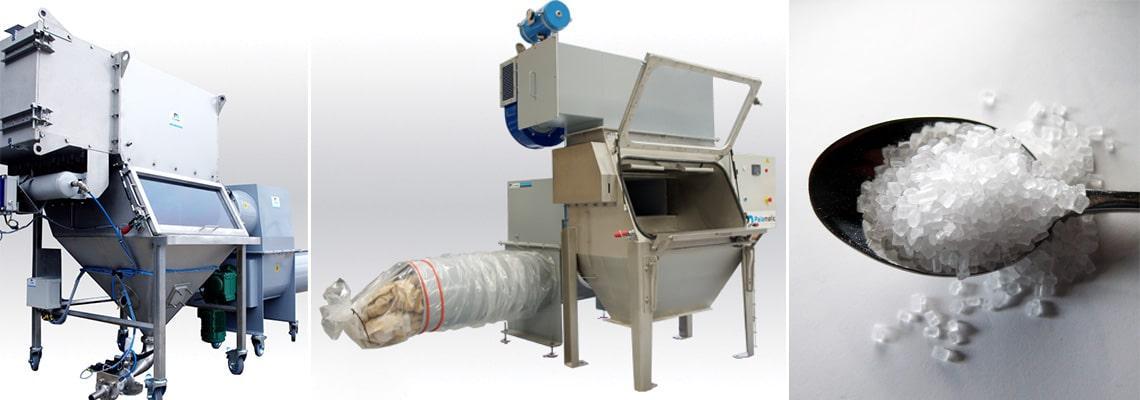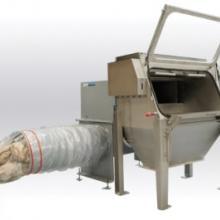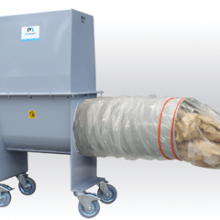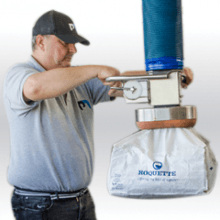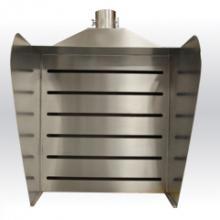Ergonomically designed bag dump station for the safe and contained handling of bags of sugar
Material: Granulated Sugar
Project Objective:
Our client, located in Okmulgee, OK, is a global leader in producing naturally derived food ingredients for raw material supplies to manufacturers in the food and beverage industry. They were experiencing several issues regarding their sugar loading and conveying operation at their plant. Operators had to manually open and dump 50 lbs sacks of granulated sugar into a 4” pneumatic conveying line. A small feed hopper with a rotary valve would allow the material to be fed into the line. However, due to the poor design of the feed system and manually intensive labor it required the end result was a dusty work environment and operator fatigue leading to injury such as shoulder and back strains. Our team was tasked with supplying equipment that would allow the safe and ergonomic handling of these heavy bags, as well as contain any dust and possible material spills. The production rate requirement was 50 bags of sugar per hour. The equipment also had to meet NFPA HAZLOC requirements for a classification 2 and division 2 combustible dust rated area.
Industrial Solution:
Our team of industrial engineers put together a solution that utilized a stainless steel sack tip tray with integrated dust extraction hood, sack compactor and vacuum bag lifter. This would achieve two main goals:
- Keep the material and dust fully contained during the dumping and feeding operation and
- Make the operation safe and ergonomic to prevent operator strain and fatigue.
The Industrial Equipment:
- SACKTIP® S Manual Bag Dump Station
- Dust Extraction Hood
- Bag Compactor
- Vacuum Bag Lift Assist Station
1. Sacktip®S Manual Bag Dump Station
This bulk material handling equipment is designed for the purposes of emptying bags, buckets, pails and boxes of powders, granules or pellets. An operator accesses the inside of the station via a hinged access door with safety interlocks. He then places a 50 lbs. bag of material on the safety grid located inside the station. Using a utility knife or a semi-automated puncture blade to cut the bag open, depending on the chosen design option, the contents are then poured out. This setup allows the operator to fully empty the powder from the bag while not having to carry all the weight of it. This provides the worker a means of using the equipment to partially carry the load of the bag, therefore reducing strain and fatigue.
The bottom half of the sack tip tray is a funneled hopper on a 60° angled slope to promote the core flow of the bulk solids. This cleanly and efficiently directs the contents of the bag through the discharge outlet of the bag opening station. A rotary airlock valve completes the bottom portion of the bag dump station. The rotary valve is made of an outer casing that supports a central drive shaft fitted with multiple vanes that make up the powder dosing pockets. This allows for the controlled feed and crucial air to material mix ration for the dilute phase pneumatic conveying system to properly function. Bag dump stations are a very common and cost-effective means for safely unloading bags of material into your downstream manufacturing process.
2. Dust Extraction Hood
Due to the dusty nature of sugar, it is essential that good housekeeping habits are followed for any industrial plant working with this substance. Sugar handling processes often fall under NFPA HAZLOC requirements due to the ability of sugar to combust given the right circumstances (free floating dust, oxygen saturation and energy source). To keep the dust fully contained it was decided to integrate a small dust collection unit on top of the bag dump station. A cylindrical pleated filter takes up the upper portion of the material handling station. It is inserted via a bolted access door on the side of the unit that allows an operator to remove and replace it as necessary. An exhaust fan pulls a slight atmospheric vacuum from inside the bag dump station. As an operator dumps out the powder, any free-floating dust particulates are sucked into the filter cartridge. The clean air escapes through the exhaust vent. The motor on the dust collection system is rated for a Class 2 / Div 2 hazardous area. A small pressurized air tank offers self-cleaning functions for the dust extraction hood. A timer sends blasts of clean air through the inside of the filter cartridge. This is often referred to as reverse pulse jet cleaning. Any excessive dust build up is knocked off the filter and allowed to funnel down through the hopper, minimizing product loss. The filtering elements are sized according to the application, but in this instance were 8m² filtering area of 8 pockets with a length of 3 feet. The filtering media used was a polyester felt with olea-hydrophobic treatment.
3. Bag Compactor
If the process requires full containment of any material spills and exposure to dust around the work station, then what should the operators do with the empty bag waste? Typically, industrial operators would take the sack and throw it into a waste receptable bin placed near the bulk material unloading station. However, in the process of doing so residual powder may be flung into the air and spill on the ground. This would defeat the purpose of using a bag dump station to keep the environment clean and safe.
Therefore, Palamatic Process offers an integrated bag compacting solution with our bag dump stations. A small unit is attached to the side or the bag of the sack tipping station. Once the operator dumps the material out of it, he then throws the bag through an opening that feeds the bag waste into a small chamber. At the bottom of the feed chamber is an auger screw that pushes the bag waste into a long cylindrical compaction tube. A poly plastic sleeve is fitted around the outside of the tube and bunched up so that the end of the bag is flat with the tube exit. The sleeve is held in place by rubber tensioning rings to firmly secure the plastic sleeve. As the bags build up inside the compaction chamber, the pressure pushes the sleeve outwards causing it to grow in length. As the length of the sleeve continues to grow, the operator must twist and zip tie the end of the sleeve to cut it off and begin the next sleeve to be stuffed. The first link can be safely removed and thrown way as both ends are secured and any residual material is trapped inside. This bag compacting equipment completes the fully closed and contained circuit of your bag dumping operation.
4. Vacuum Bag Lift Assist
In a typical bag emptying operation, laborers must conduct repetitive actions on a daily basis. These actions involve the lifting, cutting, opening and dumping of 50 lbs. sacks of powders. As we well know, repetitive motions such as these can lead to straining the neck, shoulders and back. The sack manipulator offered by Palamatic Process is designed to alleviate the risk of injury from repetitive motions and heavy lifting by using a vacuum to carry the load of the bag. A large boot, fitted with a soft exterior gasket, is fitted with a long accordion style vacuum hose. This is connected to a festoon track on a jib crane that allows for both inward and outward maneuverability, as well as 260° rotation. An operator can use one hand for the operation and maneuvering of the controls and placement of the bag. The control handle increases or decreases the amount of suction from the vacuum pump through an air control valve. By lifting the handle, the vacuum is increased which causes the bag to be lifted into the air. Vice versa, lowering the handle in turn lowers the bag until the vacuum is fully cut off, releasing the bag onto the sack tip safety tray. Operation of the bag lifting system is effortless and can be done with one hand. The supporting jib crane is mounted to the floor next to the bag dump station, allowing access to both the station and the nearby pallet of sacks.
Contact one of our powder experts today for assistance with your industrial project by clicking here.














